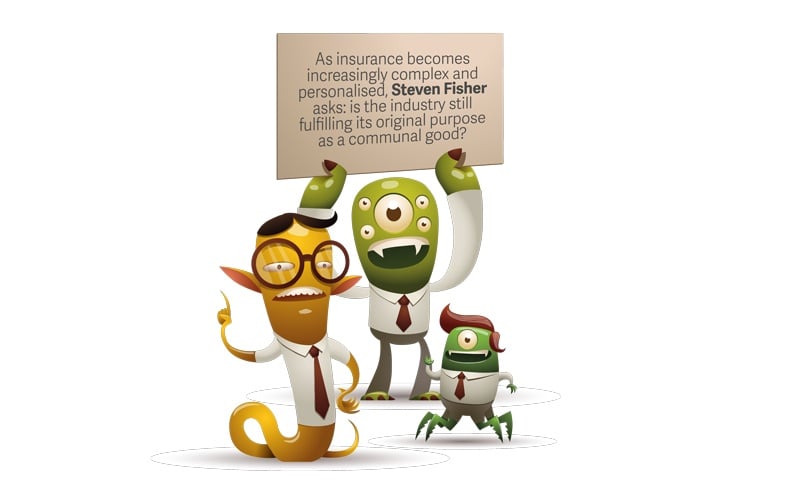
It’s an uncomfortable question. But with the insurance industry’s motives sometimes treated with scepticism, it’s a question that actuaries need to be prepared to confront.
It’s also a question that the IFoA’s Insurance as a Force for Social Good Working Party has been thinking about, and we have a clear and simple answer: no, we are not the baddies. Indeed, we can go much further than this: throughout human history, insurance has been a critical force for the reduction of human suffering and the promotion of societal progress.
At heart, insurance mitigates negative impacts for those who suffer misfortune. It’s a fact of life that bad things happen – and when misfortune strikes, insurance plays a key role in reimbursing the financial cost or providing an income in the event of a major accident or illness. It can also prevent some of the wider ripple effects: think of the job losses that would follow if a business suffered losses without recourse to insurance.
But the social benefits of insurance are so much greater than this. To explore this further, let’s begin at the beginning.
A brief history
From the earliest days of human civilisation, societies have developed structures that are recognisable today as insurance. Nearly 4,000 years ago, in ancient Assyria, the Code of Hammurabi included provisions under which a merchant seeking a loan to fund a shipment would pay the lender an additional sum in return for a guarantee that the lender would cancel the loan if the shipment sank or were stolen.
In later ancient sources, we see the emergence of the concept of general average: rules were developed under which losses would be shared among traders if a portion of a ship’s cargo needed to be jettisoned to prevent a shipwreck, or if a caravan of merchants were robbed.
In both instances, the aim was to oil the wheels of economic development. Trade was already recognised in the ancient world as a driver of wealth generation but the risk inherent in long-distance land or sea journeys was a potential barrier. And so these early societies developed risk mitigation mechanisms – which we now call insurance – to remove these barriers.
To this day, the modern insurance industry continues to play its role in promoting economic progress. Whether it’s through the direct facilitation of trade or other major capital investments, or simply by freeing up capital that would otherwise be required to protect against risk, it plays a key role in encouraging the entrepreneurship upon which so much of our modern society depends.
Other benefits gradually emerged as the modern insurance industry began to bloom during the 17th century. Insurers did not just compensate losses that had already occurred but also began promoting measures to prevent or reduce potential losses.
For example, the first fire brigades that sprung up in London following the Great Fire of 1666 were private operations run by local insurers. Research indicates that these insurer-owned fire brigades did not limit themselves to protecting their own insured properties; rather they recognised – perhaps through self-interest – the contagion risk of fire spreading to their own policyholders.
Around the same time, the new marine insurance market, centred around Edward Lloyd’s Coffee House, was to play its own role in the development of marine safety. Lloyd’s underwriters were instrumental in popularising the use of the Plimsoll line on ships – a simple innovation that ensured ships did not leave the dock dangerously overloaded.
In a similar vein, we see modern insurers playing an active role in promoting risk management, from fire safety measures as a condition of insurance to behaviour-changing technological innovations such as telematics (‘black’) boxes that incentivise safer driving.
As the world entered the modern era, a new wave of innovation saw the principles of insurance applied for mass social benefit. The 19th century saw the creation of workers’ compensation, sickness insurance and state pension schemes, which evolved during the 20th century into the modern welfare state.
In the 21st century, insurance is again at the forefront of social development, with micro-insurance schemes making insurance accessible to some of the world’s poorest citizens. Disaster relief is also being revolutionised by new forms of parametric insurance, which triggers payments automatically to ensure cash can arrive immediately where it’s most needed.
When insurance gets it wrong
Notwithstanding the benefits of insurance (see The big four, facing page), we must acknowledge that insurers don’t always get it right. There are some examples where insurers could do better by customers:
-
Poor service – With complaints of mis-selling or poor customer service, justification can sometimes be hard to find. As an industry, failings like this reflect poorly on us all, so we have a collective interest in treating customers fairly
-
Communication breakdown – Many people declare a preference for the lowest possible premium, others lament that they’ve had a claim denied because of a policy exclusion. But how often do people spot the connection? There’s a balancing act to strike between the lowest price and maximum coverage, but there is perhaps more work to do in explaining these trade-offs to the public
-
Unfair pricing – Who should pay more and who should pay less? Should loyal customers be charged more than those who frequently switch insurers? And is it fair if higher risk policyholders are consistently charged more than individuals who are deemed lower risk?
This last issue generates perhaps the toughest dilemma. As we stand on the threshold of an artificial intelligence revolution in pricing, with insurance premiums becoming ever more personalised, these questions will become more pertinent.
Let’s dig a little deeper.
Buying an expensive car is an active choice, so may merit a higher premium. But living in a high crime area when nowhere else is affordable is not an active choice
The perils of personalisation
Our actuarial DNA instinctively guides us to seek the most risk-reflective pricing possible. After all, an insurer that doesn’t distinguish sufficiently between risks will quickly find itself at a competitive disadvantage, falling victim to the downsides of anti-selection.
So, risk-reflective pricing is always best, right? Not necessarily. We must consider the customer perspective. How does an insurer respond to someone who discovers they have a genetic predisposition for developing cancer? Equally, how does the industry respond to an individual on a low income who lives in an area with a high crime rate? Insurers need to consider the outcomes for social solidarity in situations such as these, where individuals may be charged a higher premium that is viewed as commensurate with the underlying risk.
All of which leads us to a follow-up question: can we develop a framework that allows us to address the pros and cons of personalisation? These three principles can help us do just that:
1. Risk rating versus risk pooling
We need to acknowledge the tension between two conflicting objectives: on the one hand, a desire for ever-more-accurate risk rating; on the other, the traditional insurance principle of risk-pooling, which can allow for cross-subsidies between risks. Cross-subsidy ought not to be anathema to the insurance world: it’s a concept that’s already implicitly acknowledged in the prohibition of discrimination in pricing, and in schemes such as Flood Re in the UK, designed to ensure the availability of affordable flood insurance.
2. Behaviour versus luck
We need to know when, and when not, to personalise. Perhaps the guiding feature should be one of agency. Are we distinguishing between behaviours, which is a matter of policyholder choice, or between good and bad luck, over which policyholders have no control? Buying an expensive car is an active choice, so may merit a higher premium. Conversely, living in a high crime zone when nowhere else is affordable is not an active choice, and ought not to be penalised with higher insurance costs.
3. A role for regulation
We must recognise that these principles may run contrary to competitive pressures. A single insurer that acts alone to apply cross-subsidies will quickly find itself the victim of anti-selection. All insurers must act together if such outcomes are to be averted – and realistically, such collective action can only happen if and when mandated by the regulators. Price walking in the UK could be effectively tackled only with regulatory intervention, and the same applies for the less healthy implications of personalisation.
The big four: main ways insurance benefits society
-
Mitigating impacts for those who suffer losses
-
Oiling the wheels of the economy by encouraging entrepreneurship
-
Promoting risk management measures
-
Facilitating scientific and social development.
A light on the horizon
The emergence of new technology brings ethical challenges and threats – but also an opportunity to innovate. The examples below are but a small selection of current initiatives that are already making a difference, each of which could merit an article of its own. Together they give a flavour of what’s possible.
-
The industry is narrowing the insurance gap through micro-insurance programmes, extending coverage to vulnerable communities most exposed to natural disasters, which have historically had no access to such cover. Parametric insurance is being applied to disaster relief efforts, enabling cash to reach the places where it’s most needed as quickly as possible
-
Insurers are embracing a role as a positive force for the environment, prioritising underwriting capacity to focus on sustainable risks, and steering away from more harmful activities. Meanwhile, the claims process is being re-engineered to prioritise repair over replacement, to implement eco-friendly recycling or disposal practices, and to build back better in post-claim reconstruction – for example by replacing carbon-based technologies with renewable alternatives
-
Insurers are increasingly adopting a customer-centric approach, leveraging artificial intelligence to revolutionise their services while image recognition software expedites claims assessment and settlement. Telematics technology is incentivising safer driving habits
-
Insurers are fostering public and private sector partnerships to share industry expertise, boosting awareness of risk mitigation opportunities. By aligning their strategies with societal and environmental considerations, insurers aim to serve society, people and the planet better.
If insurers can successfully capitalise on the opportunities for positive innovation, and avoid the pitfalls that can come with new technology, then its future contribution to the social good can be as powerful as it has been during the past 4,000 years.
Thanks to Insurance as a Force for Social Good Working Party members Jamie Brennan, Mathilde Haran, Rachel O’Connell and Richard Winter.
Steven Fisher is a director at Deloitte and chair of the IFoA’s Insurance as a Force for Social Good Working Party
Image credit | Shutterstock
This post was originally published on this site be sure to check out more of their content.



